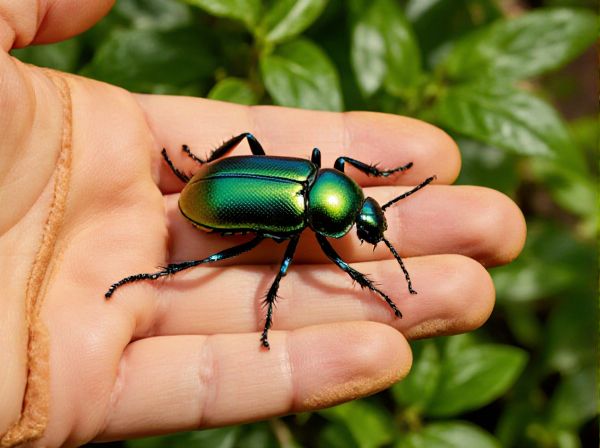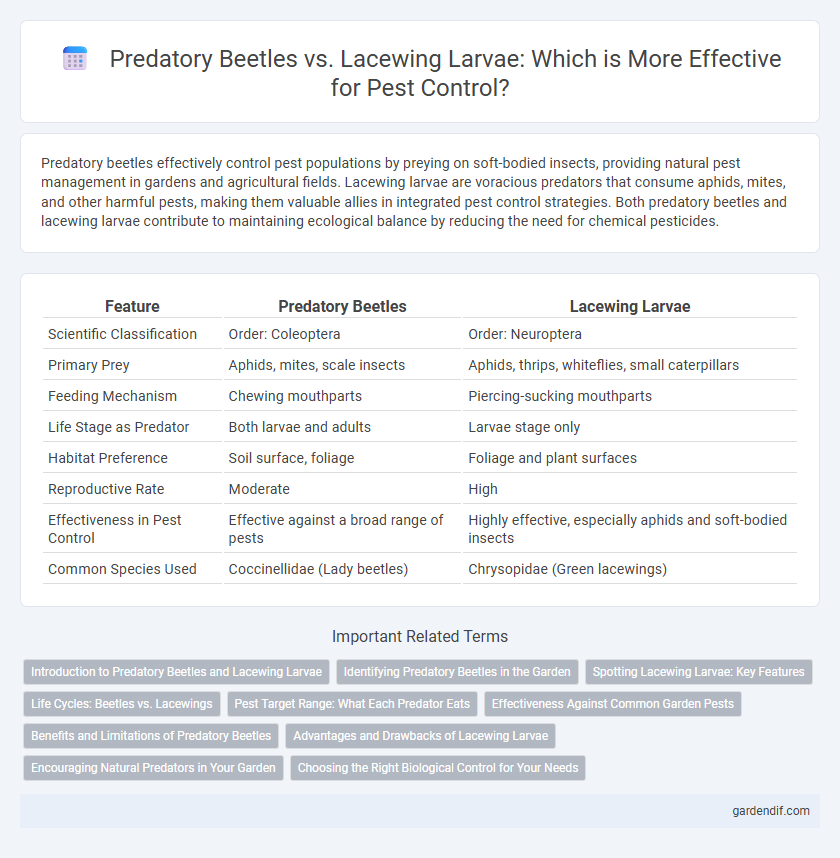
Predatory beetles vs lacewing larvae Illustration
Predatory beetles effectively control pest populations by preying on soft-bodied insects, providing natural pest management in gardens and agricultural fields. Lacewing larvae are voracious predators that consume aphids, mites, and other harmful pests, making them valuable allies in integrated pest control strategies. Both predatory beetles and lacewing larvae contribute to maintaining ecological balance by reducing the need for chemical pesticides.
Table of Comparison
| Feature | Predatory Beetles | Lacewing Larvae |
|---|---|---|
| Scientific Classification | Order: Coleoptera | Order: Neuroptera |
| Primary Prey | Aphids, mites, scale insects | Aphids, thrips, whiteflies, small caterpillars |
| Feeding Mechanism | Chewing mouthparts | Piercing-sucking mouthparts |
| Life Stage as Predator | Both larvae and adults | Larvae stage only |
| Habitat Preference | Soil surface, foliage | Foliage and plant surfaces |
| Reproductive Rate | Moderate | High |
| Effectiveness in Pest Control | Effective against a broad range of pests | Highly effective, especially aphids and soft-bodied insects |
| Common Species Used | Coccinellidae (Lady beetles) | Chrysopidae (Green lacewings) |
Introduction to Predatory Beetles and Lacewing Larvae
Predatory beetles and lacewing larvae are natural pest control agents known for their effectiveness in managing agricultural and garden pests. Predatory beetles, such as ladybugs and ground beetles, actively hunt aphids, mites, and other harmful insects, contributing to ecological balance. Lacewing larvae, often called aphid lions, consume large quantities of soft-bodied pests, making them invaluable biological controls in integrated pest management systems.
Identifying Predatory Beetles in the Garden
Predatory beetles, such as ladybugs and ground beetles, are key beneficial insects in garden pest control due to their distinctive hard, shell-like wing covers and mobile antennae. They can be identified by their smooth, shiny bodies and often brightly colored or patterned elytra, differentiating them from lacewing larvae, which possess elongated, soft bodies with large mandibles. Monitoring for these beetles is essential as they voraciously consume aphids, mites, and other pest insects, contributing to a natural, chemical-free garden management strategy.
Spotting Lacewing Larvae: Key Features
Lacewing larvae exhibit elongated, curved mandibles designed for piercing and sucking sap-sucking pests like aphids. Their soft, segmented bodies are often mottled with brown or gray, providing camouflage among leaves, while their distinctive large, forward-facing eyes enhance prey detection. In contrast, predatory beetles typically have harder, more robust exoskeletons and shorter mandibles, making the delicate mandibles and agile, slender form of lacewing larvae key identification markers in pest management.
Life Cycles: Beetles vs. Lacewings
Predatory beetles undergo complete metamorphosis with egg, larva, pupa, and adult stages, typically lasting several weeks to months depending on species and environmental conditions. Lacewing larvae develop rapidly through three instar stages before pupating, often completing their life cycle faster than beetles, which allows for multiple generations within a single growing season. The differing life cycle durations and development stages of beetles and lacewings influence their predation efficiency and timing in controlling pest populations.
Pest Target Range: What Each Predator Eats
Predatory beetles primarily target a broad range of soft-bodied insects, including aphids, caterpillars, and larvae of various pests, effectively controlling caterpillar infestations and beetle larvae. Lacewing larvae specialize in consuming aphids, whiteflies, thrips, and other small, soft-bodied pests, making them highly efficient in reducing populations of sucking pests in gardens and agricultural fields. Both predators contribute to integrated pest management by targeting overlapping yet distinct pest ranges, enhancing biological control diversity.
Effectiveness Against Common Garden Pests
Predatory beetles, such as ladybugs, effectively control aphids and scale insects by consuming large numbers quickly, making them ideal for immediate pest reduction in gardens. Lacewing larvae target a broader range of garden pests including mites, caterpillars, and whiteflies, offering comprehensive pest suppression over extended periods. Both predators contribute significantly to integrated pest management by reducing reliance on chemical pesticides through natural predation.
Benefits and Limitations of Predatory Beetles
Predatory beetles offer significant benefits in pest management by effectively controlling aphids, scale insects, and other crop-damaging pests through their voracious appetite and adaptability to various environments. However, their limitations include slower population growth compared to pests and dependence on specific habitat conditions, which may reduce their impact in monoculture agricultural settings. Despite these constraints, integrating predatory beetles into integrated pest management (IPM) programs enhances sustainable pest control and decreases reliance on chemical pesticides.
Advantages and Drawbacks of Lacewing Larvae
Lacewing larvae are highly effective biological control agents known for their voracious appetite for aphids, mites, and other soft-bodied pests, providing natural pest suppression in gardens and crops. Their adaptability to various environments and ability to target multiple pest species make them advantageous for integrated pest management. However, lacewing larvae require careful environmental conditions to thrive and may struggle in areas with heavy pesticide use or where prey populations are insufficient, limiting their efficacy in some agricultural settings.
Encouraging Natural Predators in Your Garden
Predatory beetles and lacewing larvae serve as effective natural pest controllers by feeding on aphids, mites, and other harmful garden insects. Encouraging these beneficial predators involves planting diverse, pollen-rich flowers and minimizing pesticide use to create a welcoming habitat. Integrating native plants and providing shelter improves predator survival rates, enhancing ecological balance and reducing pest populations naturally.
Choosing the Right Biological Control for Your Needs
Predatory beetles excel at targeting soil-dwelling pests such as grubs and aphids, making them ideal for garden beds and turf areas. Lacewing larvae are more versatile, preying on a broader range of soft-bodied insects including aphids, whiteflies, and mealybugs, suitable for greenhouse or indoor plant protection. Evaluating pest type, environment, and plant species helps optimize the effectiveness of biological control agents.
Predatory beetles vs lacewing larvae Infographic

 gardendif.com
gardendif.com